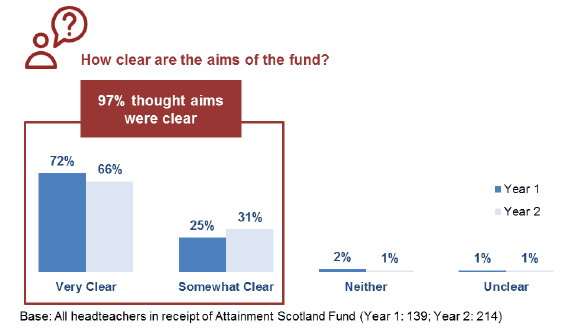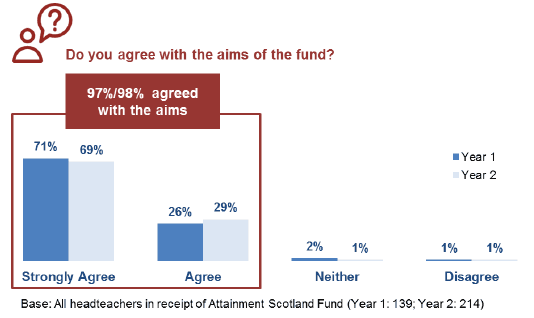Attainment Scotland Fund evaluation: interim report (years 1 and 2)
The evaluation aims to provide learning about the overall implementation of the Attainment Scotland Fund over its first two years.
5. Engagement with Programme Aims
5.1. This chapter explores stakeholders' understanding and engagement with the aims of the Attainment Scotland Fund.
5.2. As set out in the introductory chapter (see Chapter 1), the fund supports the long term aim of the Scottish Attainment Challenge, which is to close the poverty related attainment gap by focusing on improving Numeracy and Literacy attainment and Health and Wellbeing of pupils living in areas adversely affected by poverty. While the long term aim is the same for the Scottish Attainment Challenge and the specific Attainment Scotland Fund, for evaluation purposes and maximising consistency and clarity, data was collected around understanding of the aims of the fund specifically.
5.3. The first section of this chapter focuses on the overall understanding of the fund aims. It considers perceptions about the clarity of the aims amongst headteachers, strategic stakeholders and parents.
5.4. The second section explores the extent to which stakeholders supported the aims of the fund. It considers information from schools and local authorities describing how they had taken forward what they perceived as the aims of the fund within their local context.
Chapter Highlights – Engagement with Programme Aims
- The aims of the fund, particularly in terms of enhancing attainment and equity, were clear amongst stakeholders.
- Overall, local authorities and teachers were committed to the aims of the fund.
- Those who raised concerns about the programme aims, highlighted concerns around:
- raising attainment of all children
- supporting initiatives beyond school, including out of school support
- expanding the fund to cover Early Years
To what extent did stakeholders understand the programme aims?
5.5. Information about how well the aims of the fund were understood was gathered from headteachers taking part in the online survey as well as from in-depth interviews with strategic stakeholders and parents taking part in the qualitative research.
5.6. Overall, these stakeholders felt that the aims of the fund, particularly in terms of raising attainment and enhancing equity, were clear.
5.7. This section describes in turn headteachers, strategic stakeholders and parents' awareness and understanding of the programme aims. Local authorities were not asked directly about their understanding of the programme aims and their perspectives are discussed in more detail in the next section.
Headteachers
5.8. Awareness of the aims of the fund was widespread and at the forefront of headteachers' minds. Overall, 98% of headteachers were able to explain with their own words the aims of the fund, mentioning: raising attainment, closing the gap, Literacy / Numeracy / Health and Wellbeing interventions, poverty, equity or SIMD (headteacher survey, Year 2).
5.9. Specifically, the majority mentioned that the fund aims to close the poverty related attainment gap or raise attainment (84% in Year 2 of the headteacher survey). Other headteachers provided more general descriptions of the aims of the fund referring to 'mitigating the impact of poverty' (59% of respondents in Year 2) or 'enhancing equity' (31% of respondents in Year 2).
5.10. Around a quarter of headteachers mentioned that the aims involved a focus specifically on Literacy, Numeracy and Health and Wellbeing. In Year 2, 26% of respondents mentioned Literacy, 26% mentioned Numeracy and 23% mentioned Health and Wellbeing. Overall, 27% mentioned at least one of these areas of focus of the fund.
5.11. There were no headteachers who claimed not to know what the aims of the fund were or to voice a lack of certainty about them. Instead, there were some non-standard or non-detailed descriptions but they comprised only of 2% of responses.
5.12. Relatedly, the aims of the fund appeared clear to headteachers from the outset of the programme. At the end of the first year of the fund, 97% of headteachers stated that the aims of the Attainment Scotland Fund were clear (72% very clear and 25% somewhat clear). By the end of the second year, results were very similar as shown in the figure below.
Figure 5.1: Clarity of the aims of the fund, headteacher survey

Strategic Stakeholders
5.13. Strategic stakeholders interviewed as part of the qualitative research perceived there to be a shared understanding of attainment, equity and excellence.
5.14. There was also a perception that local authorities out with the Challenge Authorities or Schools Programme would have a less developed understanding of the fund.
Parents
5.15. Of the nine parents interviewed in the qualitative research, most of them felt well informed about the fund. Whilst some felt that there were efforts to ensure information was widely available, others felt that more could be done to help them understand the programme aims. No evidence was collected as to whom parents thought should provide further information.
To what extent did stakeholders support the programme aims and were they motivated to engage further with them?
5.16. Respondents to the headteacher survey were asked to comment on the extent to which they agreed with the aims of the fund. Information was also gathered from the local authority mini survey, analysis of Challenge Authority reports and in-depth interviews with local authorities and teachers.
5.17. The evidence suggested that local authorities and teachers were largely committed to the aims of the fund, though some did raise concerns. Detail is provided in the paragraphs that follow.
Motivation to support programme aims
5.18. Almost all teachers and local authorities interviewed in the qualitative research said they found the programme aims very relevant to their work.
5.19. Most teachers interviewed reported that they welcomed new resources and support to help them address the poverty related attainment gap.
5.20. Some local authorities and teachers indicated that they had already begun focusing on tackling the attainment gap prior to the introduction of the Attainment Scotland Fund. For them therefore, the aims of the fund complemented, enhanced or accelerated their existing work.
"The Scottish Attainment Challenge programme has allowed us to 'turbo charge' our approach to tackling the attainment gap' (Headteacher, Challenge Authority, Primary School - Qualitative Research – Year 2)
5.21. Local authorities reported in their Year 2 reports that there was a strong commitment from teachers to raise attainment and close the poverty related attainment gap.
5.22. Overall, the vast majority of headteachers agreed with the aim of the fund from the outset of the programme. Most of them agreed strongly (71% in Year 1 and 69% in Year 2). Further detail shown in the figure 5.2.
Figure 5.2: Agreement with the aims of the fund, headteacher survey

5.23. In the local authority mini survey, respondents felt that across their authority, staff were keen to engage with professional learning opportunities that would raise attainment. This was described as an unintended positive consequence and is discussed in more detail in Chapter 14.
Concerns about the programme aims
5.24. A minority of respondents raised concerns about the programme aims. Five headteachers at the end of Year 1 and one teacher at the end of year 2 reported that they did not agree with the programme aims. These respondents felt the focus should be on, raising attainment of all children, supporting initiatives beyond school, including out-of-school support and Early Years.
5.25. Similarly, a small number of teachers and local authorities interviewed in the qualitative research indicated that the aims of the programme should include Early Years.
5.26. Some teachers taking part in the qualitative research raised concerns that the aims of the programme did not recognise that other factors, such as additional support needs, also influenced attainment.
5.27. In at least two Challenge Authorities, teachers and local authorities highlighted concerns with the overall focus on children living in SIMD 1 and 2 areas. Teachers in one Challenge Authority also noted a risk of stigmatising these children.
Contact
Learning Analysis: socialresearch@gov.scot
There is a problem
Thanks for your feedback